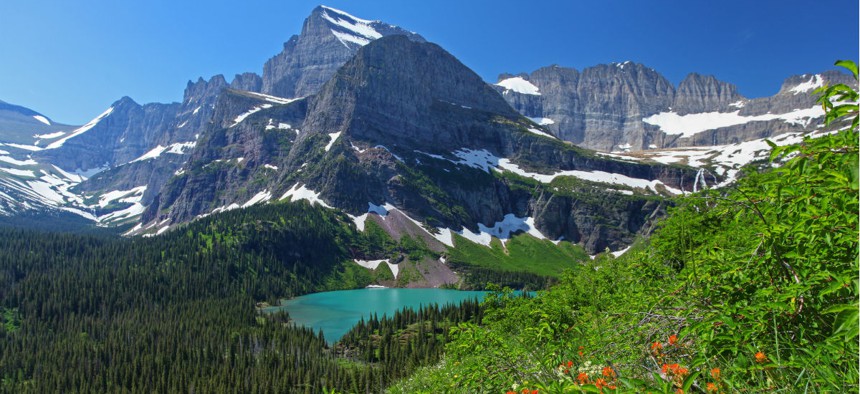
Glacier National Park in Montana. Dan Breckwoldt / Shutterstock.com
Many Lose Jobs After National Park Service Changes Interpretation of Seasonal Work Rule
Employees say a new policy barring people from working multiple seasonal jobs in a year is being applied inconsistently and retroactively.
Tracey Wiese and her husband Bruce Carter have been employees of the National Park Service for more than 30 years. For the entirety of their careers at the agency, they have served as seasonal employees switching between different parks during the year and actively chose not to pursue permanent positions.
“We’ve worked seasonally for all of that time, and that’s been our choice,” Wiese said. “Some people try to get a permanent job [after doing seasonal work], but we like the jobs we have and we like going to different parts of the country.”
For the last decade, they have been back country rangers at Glacier National Park in northern Montana in the summer, doing everything from law enforcement and emergency response to education and trail maintenance. And at other times of the year, they have taken additional seasonal jobs in Alaska, at Yosemite National Park and the Grand Canyon.
But following a recent and unannounced change in how NPS interprets rules governing seasonal hiring, Wiese and Carter were stripped of their rehire statuses and are jobless, just weeks before the start of the summer park season.
In 1994, the Office of Personnel Management established a rule that agency “subdivisions” can appoint and rehire employees in seasonal jobs, provided they worked for less than 1,040 hours during a given service year. For years, the Park Service interpreted this rule to be a cap on seasonal workers’ employment at an individual park, but allowed and encouraged those employees to effectively double up: work at one park for the summer months, and then at a different park during the winter.
But this spring, NPS has apparently changed that policy, interpreting the 1,040 hour-per-year rule to be Park Service-wide. Regional offices have been enforcing the change, which has not been formally announced, by stripping workers of their rehire status, which allows managers to bring back past seasonal workers without going through the competitive hiring process. Enforcement has also been inconsistent and retroactive, advocates for the affected workers said.
Wiese said that frequently when seasonal workers hoped to transition to permanent employment, their managers encouraged working at another park in the same year, as a way to gain experience and bolster their resume.
National Treasury Employees Union National President Tony Reardon sent a letter to members of Congress Monday requesting assistance in the matter. According to Reardon, in the Pacific West Region, officials are barring employees from future seasonal jobs if they worked more than 1,039 hours in a year since 2014. But the Intermountain Region “has no limit on retroactivity.” Further complicating matters, workers were not informed of their situation until after the competitive hiring deadline had passed.
“Some are being told that they can sign up for a six-month contract and they will be terminated after that; while others are being told that they went over the 1,039-hour cap in the past, and are now permanently banned from working in the parks,” Reardon wrote. “[Each] region, and each park, seems to have its own rules. Apparently, there is no uniform policy in place, so many inconsistent approaches have arisen.”
The National Park Service did not respond to requests for comment.
Wiese said the situation is particularly frustrating because she had been in touch with Glacier Park’s HR officials, anticipating potential changes to the hiring and re-hiring process in light of a new administration, and was told an entirely different interpretation of the rule would take effect.
“I don’t know what we could have done differently,” she said. “Last September, we even asked our HR office about this, and they said it’s fine. You won’t be able to work [at different parks] in one region in both summer and winter, but if you go to a park in a different region, that’s OK. And now, anyone who followed that direction has lost their jobs.”
Wiese and Carter may still be hired back to Glacier National Park. Although they were not informed of the loss of their rehire status until after the deadline to apply competitively, Wiese said the park did not receive enough qualified applicants and the couple has applied to a second call for resumes.
“We individually have the opportunity to apply and compete again, which we’re doing; we’ve applied,” Wiese said. “But that doesn’t resolve the issue, because we’ll have to go through the same thing again next year. And even if we are hired, and I hope we are, normally we start on the first day of May, and I don’t think there’s any possibility of that happening this year.”
NEXT STORY: Want To Be Happier? Little Changes Can Help







